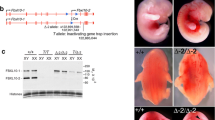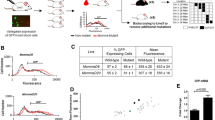Abstract
The brachyury, or T, locus encodes a transcription factor that plays a crucial role in the early development of all animals. In the mouse, animals heterozygous for a null mutation at this locus are born with a characteristic short tail. Expressivity of the short tail phenotype is greatly affected by genetic background. As a genetic entry into the identification of genes that interact with the Brachyury locus, we have performed a QTL analysis for modifiers of this phenotype. Surprisingly, we discovered that the major modifiers uncovered all act in a sex-limited manner. We have identified two QTLs—Brm1 on Chr 9 and Brm2 on Chr 15—that act only in female offspring(N2) from female T/+ parents(F1) and are responsible together for most, or all, of the genetic variance in phenotypic expression observed between C57BL/10 and C3H/HeJ animals.
Similar content being viewed by others
References
Beechey CV, Cattanach BM (1997) Genetic and physical imprinting map of the mouse. Mouse Genome 95, 100–105
Dietrich WF, and others (1994) A genetic map of the mouse with 4,006 simple sequence length polymorphisms. Nature Genet 7, 220–245
Dobrovolskaia-Zavadskaia N, Kobozieff N (1927) Sur la reproduction des souris anoures. C. R. Séanc Soc Biol 97, 116–119
Garber ED (1952) “Bent tail,” a dominant, sex-linked mutation in the mouse. Proc Natl Acad Sci USA 38, 876–879
Herrmann BG, Kispert A (1994) The T genes in embryogenesis. Trends Genet 10, 280–286
Herrmann BG, Labeit S, Poustka A, King T, Lehrach H (1990) Cloning of the T gene required in mesoderm formation in the mouse. Nature 343, 617–622
Lander E, Kruglyak L (1995) Genetic dissection of complex traits: guidelines for interpreting and reporting results. Nature Genet 11, 241–247
Lane PW (1987) Abnormal feet and tail (Aft) Mouse News Lett 78, 56–57
Maniatis T, Hardison RC, Lacy E, Lauer J, O’Connell C, Quon D, Sim GK, Efstratiadis D (1978) The isolation of structural genes from libraries of eucaryotic DNA. Cell 15, 687–697
Martinez O, Curnow RN (1992) Estimating the locations and the sizes of the effects of quantitative trait loci using flanking markers. Theor Appl Genet 85, 480–488
Schmahl W, Favor MKJ, Davidson D (1993) Defects of neuronal migration and the pathogenesis of cortical malformations are associated with Small eye (Sey) in the mouse, a point mutation at the Pax-6-locus. Acta Neuropathol 86, 126–135
Xu S, Atchley WR (1995) A random model approach to interval mapping of Quantitative Trait Loci. Genetics 141, 1189–1197
Author information
Authors and Affiliations
Rights and permissions
About this article
Cite this article
Agulnik, I.I., Agulnik, S.I., Saatkamp, B.D. et al. Sex-specific modifiers of tail development in mice heterozygous for the brachyury (T) mutation. Mammalian Genome 9, 107–110 (1998). https://doi.org/10.1007/s003359900698
Received:
Accepted:
Issue Date:
DOI: https://doi.org/10.1007/s003359900698




